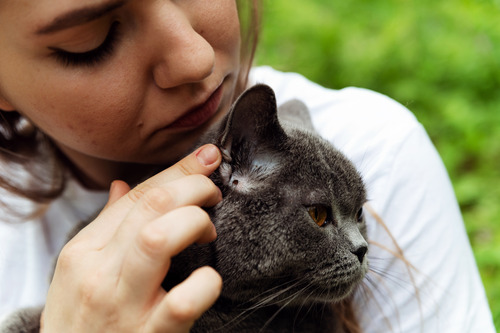Ticks can cause serious health issues for cats, which is why knowing how to remove a tick from a cat safely is so important. Creekside Pet Care Center is here to provide you with essential guidance to help protect your cat from these pesky parasites. In this article, we’ll explain how to recognize ticks on your cat, the proper way to remove them, and tips for preventing future tick infestations. For any concerns regarding ticks or your cat’s health, call us at (817) 421-5850 to schedule an appointment.
Recognizing Ticks on Cats
Ticks are small parasitic arachnids that attach themselves to the skin of animals to feed on their blood. They come in various species, such as the American dog tick, brown dog tick, and deer tick, which can carry diseases that can harm your cat. Knowing how to remove a tick from a cat starts with understanding the basics about these pests.
Symptoms of Tick Infestation
Recognizing the symptoms of tick infestation will help you identify if your cat needs immediate attention. Look out for the following signs:
- Excessive scratching or licking of a specific area
- Red, inflamed, or irritated skin
- Small bumps or scabs
- Weakness or lethargy
- Loss of appetite
Common Places Where Ticks Hide
Ticks tend to attach themselves to specific areas on your cat, including:
- Head and neck region
- Ears and around the eyes
- Under the collar
- Between toes
- Groin area
Make sure to thoroughly inspect these areas when checking for ticks.
How to Remove a Tick From a Cat
Before attempting to remove a tick from your cat, make sure you have the necessary tools ready. Specially designed tick removal tools like tick twisters or tick hooks can make the process easier. If a tick removal tool isn’t available, fine-tipped tweezers can be used as an alternative. Wear gloves to prevent contact with the tick and any possible pathogens. Prepare an antiseptic solution to clean the bite area after tick removal. Have a container with a lid on hand to safely dispose of the tick. You might want to use a magnifying glass to help see the tick clearly.
Step-by-Step Tick Removal Process
Here’s a step-by-step guide on how to remove a tick from a cat safely:
- Wear Gloves: Put on gloves to avoid direct contact with the tick.
- Part the Fur: Use your fingers or a comb to part the fur and reveal the tick clearly.
- Use the Tick Removal Tool or Tweezers:
- If using a tick removal tool, position the tool around the tick as close to your cat’s skin as possible.
- For tweezers, grasp the tick as close to the skin as possible, ensuring you hold it firmly.
- Pull Out the Tick:
- With the removal tool, gently twist and pull upwards.
- With tweezers, pull the tick straight out with steady pressure.
- Ensure Complete Removal: Make sure you remove the entire tick, including its mouthparts. Use a magnifying glass to check.
- Dispose of the Tick:
- Place the tick in a container with a lid or flush it down the toilet.
- Do not crush the tick with your fingers.
- Clean the Bite Area: Apply antiseptic solution to the bite area to prevent infection.
- Monitor the Bite Area: Watch the area over the next few days for any signs of redness, swelling, or irritation.
When to Call the Vet
Sometimes removing a tick from a cat requires professional assistance, especially if the tick is deeply embedded or in a sensitive area, or if the mouthparts remain embedded after removal, or if your cat shows signs of illness. If you’re unsure how to safely remove the tick, your veterinarian can help you with that as well. If you’re concerned about your cat’s health, call Creekside Pet Care Center at (817) 421-5850.
Preventing Tick Infestations
Tick Prevention Products
To prevent tick infestations, it’s important to consistently use tick prevention products. Topical solutions can be applied to your cat’s skin, lasting for several weeks. Oral medications are given by mouth and provide protection for up to a month, while tick collars offer long-lasting defense by repelling ticks around the neck and head. Tick sprays can also be used on your cat’s fur as well as their bedding and other areas. Consult your veterinarian to determine which product suits your cat best.
Environmental Control Measures
In addition to prevention products, controlling the environment can help reduce tick infestations. Keep your lawn mowed, remove leaf litter and tall grasses, and add gravel or wood chips around your yard to limit tick migration. Regularly inspect and wash your cat’s bedding, treating it with tick sprays if needed. Grooming your cat frequently, especially if they have long hair, helps catch ticks early.
Regular Tick Checks
Performing regular tick checks is key to early detection. Run your fingers through your cat’s fur, paying extra attention to the head, neck, ears, and between toes. This simple routine can help catch ticks before they cause significant harm.
Understanding Tick-Borne Diseases
Ticks can transmit various diseases to cats, making it essential to know the risks. Some common tick-borne diseases include:
Lyme Disease
Although rare in cats, Lyme disease can occur. Symptoms include lethargy, fever, and swollen joints.
Cytauxzoonosis
A potentially fatal disease caused by the parasite Cytauxzoon felis, which is spread by ticks. Symptoms include fever, loss of appetite, and difficulty breathing.
Haemobartonellosis
Caused by the bacteria Mycoplasma haemofelis, leading to anemia and fever.
Protecting Your Feline From Ticks
Knowing how to remove a tick from a cat is crucial for every pet owner, as ticks pose significant health risks. At Creekside Pet Care Center, we prioritize your cat’s well-being and provide comprehensive tick prevention and removal services. If your cat has been bitten by a tick or you need advice on tick prevention, call us at (817) 421-5850 to schedule an appointment. By following the tips provided here and staying vigilant with tick checks and prevention products, you can help keep your cat safe from these pesky parasites.






